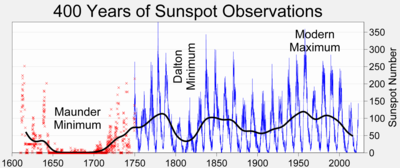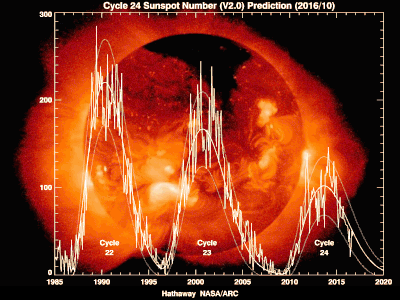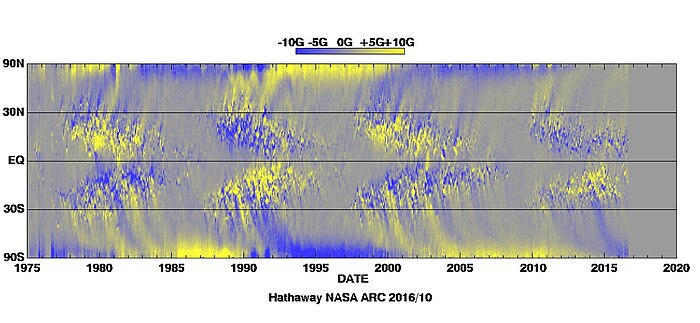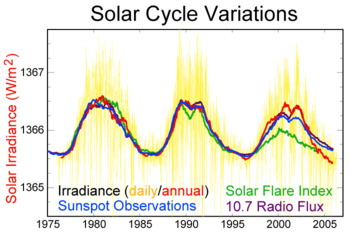| Revision as of 16:19, 27 July 2015 editLfstevens (talk | contribs)Extended confirmed users68,781 edits →top: reorgTag: Visual edit← Previous edit | Revision as of 06:13, 5 August 2015 edit undoLfstevens (talk | contribs)Extended confirmed users68,781 edits +modelsTag: Visual editNext edit → | ||
| Line 9: | Line 9: | ||
| It is powered by changes in the sun's interior. | It is powered by changes in the sun's interior. | ||
| ==Models== | |||
| ⚫ | ==Scientific history== | ||
| === Double dynamo === | |||
| In 2015, a new model of the solar cycle was published that produced more accurate predictions of solar irregularities. The model draws on dynamo effects in two layers of the Sun, one close to the surface and one deep within its ]. Model predictions suggest that solar activity will fall by 60 per cent during the 2030s to conditions last seen during the ']' that began in 1645. Prior models included only the deeper dynamo.<ref name=":1">{{Cite web|title = Solar activity predicted to fall 60% in 2030s, to 'mini ice age' levels: Sun driven by double dynamo|url = http://www.sciencedaily.com/releases/2015/07/150709092955.htm|website = www.sciencedaily.com|accessdate = 2015-07-11|publisher = Science Daily|date = July 9, 2015}}</ref> | |||
| The model features paired magnetic wave components. Both components have a frequency of approximately 11 years, although their frequencies are slightly different and temporally offset. Over the cycle, the waves fluctuate between the Sun's northern and southern hemispheres.<ref name=":1" /> | |||
| The model used ]' of the ] observations from the Wilcox Solar Observatory. They examined magnetic field activity from ]-], covering 1976-2008. They also compared their predictions to average ] numbers. The model was 97% accurate in predicting solar activity fluctuations.<ref name=":1" /> | |||
| ⚫ | == Scientific history == | ||
| ] | ] | ||
| ] | ] | ||
Revision as of 06:13, 5 August 2015
This article is about the sunspot cycle. For 28-year cycle of Julian calendar, see Solar cycle (calendar).

The solar cycle or solar magnetic activity cycle is the periodic change in the Sun's activity (including changes in the levels of solar radiation and ejection of solar material) and appearance (changes in the number of sunspots, flares and other manifestations). Solar cycles have an average duration of about 11 years. They have been observed (by changes in the sun's appearance and by changes seen on Earth, such as auroras) for centuries.
Cycles cause changes on the sun, in space, in the atmosphere and on the Earth's surface. While it is the dominant variable in solar activity, aperiodic fluctuations also occur.
It is powered by changes in the sun's interior.
Models
Double dynamo
In 2015, a new model of the solar cycle was published that produced more accurate predictions of solar irregularities. The model draws on dynamo effects in two layers of the Sun, one close to the surface and one deep within its Convection_zone. Model predictions suggest that solar activity will fall by 60 per cent during the 2030s to conditions last seen during the 'Little ice age' that began in 1645. Prior models included only the deeper dynamo.
The model features paired magnetic wave components. Both components have a frequency of approximately 11 years, although their frequencies are slightly different and temporally offset. Over the cycle, the waves fluctuate between the Sun's northern and southern hemispheres.
The model used Principal_component_analysis' of the Magnetic_field observations from the Wilcox Solar Observatory. They examined magnetic field activity from solar cycles 21-23, covering 1976-2008. They also compared their predictions to average Sunspot numbers. The model was 97% accurate in predicting solar activity fluctuations.
Scientific history


The solar cycle was discovered in 1843 by Samuel Heinrich Schwabe, who after 17 years of observations noticed a periodic variation in the average number of sunspots. Rudolf Wolf compiled and studied these and other observations, reconstructing the cycle back to 1745, eventually pushing these reconstructions to the earliest observations of sunspots by Galileo and contemporaries in the early seventeenth century.
Following Wolf's numbering scheme, the 1755–1766 cycle is traditionally numbered "1".
The period between 1645 and 1715, a time of few sunspots, is known as the Maunder minimum, after Edward Walter Maunder, who extensively researched this peculiar event, first noted by Gustav Spörer.
In the second half of the nineteenth century Richard Carrington and by Spörer independently noted that as the cycle progresses, sunspots appear first at mid-latitudes, and then closer and closer to the equator until solar minimum is reached. This pattern is best visualized in the form of the so-called butterfly diagram, first constructed by Walter and Maunder in the early twentieth century (see graph). Images of the Sun are divided into latitudinal strips, and the monthly-averaged fractional surface of sunspots calculated. This is plotted vertically as a color-coded bar, and the process is repeated month after month to produce this time-series diagram.

Half a century later, the father-and-son team of Harold and Horace Babcock showed that the solar surface is magnetized even outside of sunspots; that this weaker magnetic field is to first order a dipole; and that this dipole undergoes polarity reversals with the same period as the sunspot cycle (see graph below). These observations established that the solar cycle is a spatiotemporal magnetic process unfolding over the Sun as a whole.

Cycle history
Starting with Wolf, solar astronomers have found it useful to define a standard sunspot number index, which continues to be used today.
Until recently it was thought that 28 cycles had spanned the 309 years between 1699 and 2008, giving an average length of 11.04 years, but recent research has showed that the longest of these (1784–1799) seems actually to have been two cycles, reducing the average length to 10.66 years.
Since observations began cycles have been as short as 9 years and as long as 14 years. In 1784-1799 one of the two component cycles had to be less than 8 years in length. Significant amplitude variations also occur.
The cycle's physical basis was elucidated in the early twentieth century by Hale and collaborators, who in 1908 showed that sunspots were strongly magnetized (the first detection of magnetic fields beyond the Earth), and in 1919 showed that the magnetic polarity of sunspot pairs:
- Is always the same in a given solar hemisphere throughout a given sunspot cycle;
- Is opposite across hemispheres throughout a cycle;
- Reverses itself in both hemispheres from one cycle to the next.
Hale's observations revealed that the solar magnetic cycle spans two "solar cycles" spanning an average of 22 years, before returning to its original state. However, because very nearly all manifestations are insensitive to magnetic polarity, common usage continues to speak of the "11-year solar cycle".
Phenomena, measurement, and causes
Sunspots may exist anywhere from a few days to a few months, but they eventually decay. Spots from two adjacent cycles can co-exist for some time, and since it was discovered that the Sun reverses magnetic polarity from one solar cycle to the next, spots from different cycles can be distinguished by direction of their magnetic field.
Sunspots are produced from a strong toroidal (longitudinally directed) magnetic field within the solar interior. Physically, the solar cycle can be thought of as a regenerative loop where the toroidal component produces a poloidal field, which later produces a new toroidal component of sign such as to reverse the polarity of the original toroidal field, which then produces a new poloidal component of reversed polarity, and so on.
Solar maximum and solar minimum refer respectively to periods of maximum and minimum sunspot counts. Individual sunspot cycles are partitioned from one minimum to the next. Definitively ascertaining the true date of solar minimum takes months after it actually happens. One of the principal authorities that determine the date of the solar minimum is SIDC (the Solar Influences Data Analysis Center), which is located in Belgium.
The most important information today comes from SOHO (a project of international cooperation between ESA and NASA), such as the MDI magnetogram, where the solar "surface" magnetic field can be seen.
The basic causes of the solar variability and its cycles are still under debate, with some researchers suggesting a link with the tidal forces due to the gas giants Jupiter and Saturn, or due to the solar inertial motion. Another cause of Sun spots can be solar jet stream "torsional oscillation".
Patterns have been noted in solar cycles. For example, the Waldmeier effect names the observation that cycles with larger maximum amplitudes tend to take less time to reach their maxima than cycles with smaller amplitudes; maximum amplitudes are negative correlated to the lengths of earlier cycles, which allows a degree of prediction.
The Sun's magnetic field structures its atmosphere and outer layers all the way through the corona and into the solar wind. Its spatiotemporal variations lead to a host of phenomena collectively known as solar activity. All of solar activity is strongly modulated by the solar magnetic cycle, since the latter serves as the energy source and dynamical engine for the former.
The solar F10.7 index is measured daily at local noon in a bandwidth of 100 MHz centered on 2800 MHz at the Penticton site of the Dominion Radio Astrophysical Observatory (DRAO), Canada. The solar F10.7 cm record extends back to 1947, and is the longest direct record of solar activity available, other than sunspot-related quantities.
Coronal mass ejection
Main article: Coronal mass ejection
The solar magnetic field structures the corona, giving it its characteristic shape visible at times of solar eclipses. Complex coronal magnetic field structures evolve in response to fluid motions at the solar surface, and emergence of magnetic flux produced by dynamo action in the solar interior. For reasons not yet understood in detail, sometimes these structures lose stability, leading to coronal mass ejections into interplanetary space, or flares, caused by sudden localized release of magnetic energy driving emission of ultraviolet and X-ray radiation as well as energetic particles. These eruptive phenomena can have a significant impact on Earth's upper atmosphere and space environment, and are the primary drivers of what is now called space weather.
The occurrence frequency of coronal mass ejections and flares is strongly modulated by the cycle. Flares of any given size are some 50 times more frequent at solar maximum than at minimum. Large coronal mass ejections occur on average a few times a day at solar maximum, down to one every few days at solar minimum. The size of these events themselves does not depend sensitively on the phase of the solar cycle. A case in point are the three large X-class flares that occurred in December 2006, very near solar minimum; an X9.0 flare on Dec 5 stands as one of the brightest on record.
Effects
Solar

Surface magnetism
Sunspots eventually decay, releasing magnetic flux in the photosphere. This flux is dispersed and churned by turbulent convection and solar large-scale flows. These transport mechanisms lead to the accumulation of magnetized decay products at high solar latitudes, eventually reversing the polarity of the polar fields (notice how the blue and yellow fields reverse in the graph above).
The dipolar component of the solar magnetic field reverses polarity around the time of solar maximum and reaches peak strength at the solar minimum.
Space
Galactic cosmic ray flux
The outward expansion of solar ejecta into interplanetary space provides overdensities of plasma that are efficient at scattering high-energy cosmic rays entering the solar system from elsewhere in the galaxy. The frequency of solar eruptive events is modulated by the cycle, changing the degree of cosmic ray scattering in the outer solar system accordingly. As a consequence, the cosmic ray flux in the inner solar system is anticorrelated with the overall level of solar activity. This anticorrelation is clearly detected in cosmic ray flux measurements at the Earth's surface.

Some high-energy cosmic rays entering Earth's atmosphere collide hard enough with molecular atmospheric constituents to cause occasionally nuclear spallation reactions. Fission products include radionuclides such as C and Be that settle on the Earth's surface. Their concentration can be measured in ice cores, allowing a reconstruction of solar activity levels into the distant past. Such reconstructions indicate that the overall level of solar activity since the middle of the twentieth century stands amongst the highest of the past 10,000 years, and that epochs of suppressed activity, of varying durations have occurred repeatedly over that time span.
Atmospheric
Total solar irradiance
Main article: Solar irradianceThe total solar irradiance (TSI) is the amount of solar radiative energy incident on the Earth's upper atmosphere. TSI variations were undetectable until satellite observations began in late 1978. A series of radiometers were launched on satellites from the 1970s to the 2000s. TSI measurements varied from 1360 to 1370 W/m2 across ten satellites. One of the satellites, the ACRIMSAT was launched by the ACRIM group. The controversial 1989-1991 “ACRIM gap” between non-overlapping satellites was interpolated by an ACRIM composite showing +0.037%/decade rise. Another series based on ACRIM data is produced by the PMOD group. Its series shows a -0.008%/decade downward trend. This 0.045%/decade difference impacts climate models.
Solar irradiance varies systematically over the cycle, both in total irradiance and in its relative components (UV vs visible and other frequencies). The solar luminosity is an estimated 0.07 percent brighter during the mid-cycle solar maximum than the terminal solar minimum. Photospheric magnetism appears to be the primary cause (96%) of 1996-2013 TSI variation. The ratio of ultraviolet to visible light varies.
TSI varies in phase with the solar magnetic activity cycle with an amplitude of about 0.1% around an average value of about 1361.5 W/m (the "solar constant"). Variations about the average of up to −0.3% are caused by large sunspot groups and of +0.05% by large faculae and the bright network on a 7-10-day timescale (see TSI variation graphics). Satellite-era TSI variations show small but detectable trends.
TSI is higher at solar maximum, even though sunspots are darker (cooler) than the average photosphere. This is caused by magnetized structures other than sunspots during solar maxima, such as faculae and active elements of the "bright" network, that are brighter (hotter) than the average photosphere. They collectively overcompensate for the irradiance deficit associated with the cooler, but less numerous sunspots. The primary driver of TSI changes on solar rotational and sunspot cycle timescales is the varying photospheric coverage of these radiatively active solar magnetic structures.
Short-wavelength radiation

With a temperature of 5870 K, the photosphere emits a proportion of radiation in the extreme ultraviolet (EUV) and above. However, hotter upper layers of the Sun's atmosphere (chromosphere and corona) emit more short-wavelength radiation. Since the upper atmosphere is not homogeneous and contains significant magnetic structure, the solar ultraviolet (UV), EUV and X-ray flux varies markedly over the cycle.
The photo montage to the left illustrates this variation for soft X-ray, as observed by the Japanese satellite Yohkoh from after August 30, 1991, at the peak of cycle 22, to September 6, 2001, at the peak of cycle 23. Similar cycle-related variations are observed in the flux of solar UV or EUV radiation, as observed, for example, by the SOHO or TRACE satellites.
Even though it only accounts for a minuscule fraction of total solar radiation, the impact of solar UV, EUV and X-ray radiation on the Earth's upper atmosphere is profound. Solar UV flux is a major driver of stratospheric chemistry, and increases in ionizing radiation significantly affect ionosphere-influenced temperature and electrical conductivity.
Solar radio flux
Emission from the Sun at centimetric (radio) wavelength is due primarily to coronal plasma trapped in the magnetic fields overlying active regions. The F10.7 index is a measure of the solar radio flux per unit frequency at a wavelength of 10.7 cm, near the peak of the observed solar radio emission. F10.7 is often expressed in SFU or solar flux units (1 SFU = 10 W m Hz). It represents a measure of diffuse, nonradiative coronal plasma heating. It is an excellent indicator of overall solar activity levels and correlates well with solar UV emissions.
Sunspot activity has a major effect on long distance radio communications, particularly on the shortwave bands although medium wave and low VHF frequencies are also affected. High levels of sunspot activity lead to improved signal propagation on higher frequency bands, although they also increase the levels of solar noise and ionospheric disturbances. These effects are caused by impact of the increased level of solar radiation on the ionosphere.
10.7 cm solar flux could interfere with point-to-point terrestrial communications.
Terrestrial
Organisms
Main article: Solar variationThe impact of the solar cycle on living organisms has been investigated (see chronobiology). Some researchers claim to have found connections with human health.
The amount of ultraviolet UVB light at 300 nm reaching the Earth varies by as much as 400% over the solar cycle due to variations in the protective ozone layer. In the stratosphere, ozone is continuously regenerated by the splitting of O2 molecules by ultraviolet light. During a solar minimum, the decrease in ultraviolet light received from the Sun leads to a decrease in the concentration of ozone, allowing increased UVB to reach the Earth's surface.
Radio communication
Main article: SkywaveSkywave modes of radio communication operate by bending (refracting) radio waves (electromagnetic radiation) through the Ionosphere. During the "peaks" of the solar cycle, the ionosphere becomes increasingly ionized by solar photons and cosmic rays. This affects the propagation of the radio wave in complex ways that can either facilitate or hinder communications. Forecasting of skywave modes is of considerable interest to commercial marine and aircraft communications, amateur radio operators and shortwave broadcasters. These users occupy frequencies within the High Frequency or 'HF' radio spectrum that are most affected by these solar and ionospheric variances. Changes in solar output affect the maximum usable frequency, a limit on the highest frequency usable for communications.
Climate
Main article: Solar variationBoth long-term and short-term variations in solar activity are hypothesized to affect global climate, but it has proven extremely challenging to quantify the link between solar variation and climate.
Early research attempted to correlate weather with limited success, followed by attempts to correlate solar activity with global temperature. The cycle also impacts regional climate. Measurements from the SORCE's Spectral Irradiance Monitor show that solar UV variability produces, for example, colder winters in the US and southern Europe and warmer winters in Canada and northern Europe during solar minima.
Three hypothetical mechanisms mediate solar variations' climate impacts:
- Total solar irradiance ("Radiative forcing").
- Ultraviolet irradiance. The UV component varies by more than the total, so if UV were for some (as yet unknown) reason having a disproportionate effect, this might affect climate.
- Solar wind-mediated galactic cosmic ray changes, which may affect cloud cover.
The sunspot cycle variation of 0.1% has small but detectable effects on the Earth’s climate. Camp and Tung suggest that solar irradiance correlates with a variation of 0.18 K ±0.08 K (0.32 °F ±0.14 °F) in measured average global temperature between solar maximum and minimum.
The current scientific consensus is that solar variations do not play a major role in driving global warming, since the measured magnitude of recent solar variation is much smaller than the forcing due to greenhouse gases, but the level of understanding of solar impacts is low.
Spacecraft
CME's produce a radiation flux of high-energy protons, sometimes known as solar cosmic rays. These can cause radiation damage to electronics and solar cells in satellites. Solar proton events also can cause single-event upset (SEU) events on electronics; at the same, the reduced flux of galactic cosmic radiation during solar maximum decreases the high-energy component of particle flux.
CME radiation is dangerous to astronauts on a space mission who are outside the shielding produced by the Earth's magnetic field. Future mission designs (e.g., for a Mars Mission) therefore incorporate a radiation-shielded "storm shelter" for astronauts to retreat to during such an event.
Gleißberg developed a CME forecasting method that relies on consecutive cycles.
See also
|
|
References
- "NASA/Marshall Solar Physics". nasa.gov.
- "Sunspot Number graphics". oma.be.
- ^ "Solar activity predicted to fall 60% in 2030s, to 'mini ice age' levels: Sun driven by double dynamo". www.sciencedaily.com. Science Daily. July 9, 2015. Retrieved 2015-07-11.
- Schwabe (1843) "Sonnenbeobachtungen im Jahre 1843" (Observations of the sun in the year 1843), Astronomische Nachrichten, 21 : 233-236. From page 235: "Vergleicht man nun die Zahl der Gruppen und der flecken-freien Tage mit einander, so findet man, dass die Sonnenflecken eine Periode von ungefähr 10 Jahren hatten … " (If one compares the number of groups and the sunspot-free days with one another, then one finds that the sunspots had a period of about 10 years … )
- Eddy, John A. (June 1976). "The Maunder Minimum". Science. 192 (4245): 1189–1202. Bibcode:1976Sci...192.1189E. doi:10.1126/science.192.4245.1189. JSTOR 17425839. PMID 17771739.
- Template:Cite DOI
- "Centuries-old sketches solve sunspot mystery". New Scientist. 1 Aug 2009. p. 10.
- H. Schwentek; W. Elling (July 1984). "A possible relationship between spectral bands in sunspot number and the space-time organization of our planetary system". Solar Physics. 93 (2): 403–13. Bibcode:1984SoPh...93..403S. doi:10.1007/BF02270851.
{{cite journal}}: Unknown parameter|last-author-amp=ignored (|name-list-style=suggested) (help) - Attila Grandpierre (December 3, 2004). "On the origin of solar cycle periodicity". Astrophysics and Space Science. 243 (2): 393–400. Bibcode:1996Ap&SS.243..393G. doi:10.1007/BF00644709.
- Charvátová I. (2000). "Can origin of the 2400-year cycle of solar activity be caused by solar inertial motion?" (PDF). Ann. Geophys. 18 (4): 399–405. Bibcode:2000AnGeo..18..399C. doi:10.1007/s00585-000-0399-x.
- Charvatova, Hejda (September 2008). "Possible role of the Solar inertial motion in climatic changes" (PDF). CA: Bill HowellTemplate:Inconsistent citations
{{cite journal}}: Cite journal requires|journal=(help)CS1 maint: postscript (link). - Waldmeier M., 1939, Astron. Mitt. Zurich, 14, 439
- Du, Zhan-Le; Wang, Hua-Ning; He, Xiang-Tao (2006). "The Relation between the Amplitude and the Period of Solar Cycles". J. Astron. Astrophys. 6 (4): 489–494. Bibcode:2006ChJAA...6..489D. doi:10.1088/1009-9271/6/4/12.
- John White; Ken Tapping (February 2012). "The Penticton Solar Flux Receiver". QST. The American Radio Relay League: 39–45.
{{cite journal}}: Unknown parameter|last-author-amp=ignored (|name-list-style=suggested) (help) - Davies, Kenneth (1990). Ionospheric Radio. IEE Electromagnetic Waves Series #31. London, UK: Peter Peregrinus Ltd/The Institution of Electrical Engineers. p. 34. ISBN 0-86341-186-X.
- "Extreme Space Weather Events". National Geophysical Data Center.
- "The Most Powerful Solar Flares Ever Recorded". Spaceweather.com.
- Solanki, Sami K.; Usoskin, Ilya G.; Kromer, Bernd; Schüssler, Manfred; Beer, Jürg (2004). "Unusual activity of the Sun during recent decades compared to the previous 11,000 years" (PDF). Nature. 431 (7012): 1084–7. Bibcode:2004Natur.431.1084S. doi:10.1038/nature02995. PMID 15510145.
- Active Cavity Radiometer Irradiance Monitor (ACRIM) solar irradiance monitoring 1978 to present (Satellite observations of total solar irradiance); access date 2012-02-03
- Richard C. Willson (2014-05-16). "ACRIM3 and the Total Solar Irradiance database". Astrophysics and Space Science. 352: 341–352. doi:10.1007/s10509-014-1961-4.
- Willson, R.C.; et al. (1981). "Observations of Solar Irradiance Variability". Science. 211 (4483): 700–2. doi:10.1126/science.211.4483.700. PMID 17776650.
{{cite journal}}: Explicit use of et al. in:|last2=(help) - K.L. Yeo; et al. (2014-09-23). "Reconstruction of total and spectral solar irradiance from 1974 to 2013 based on KPVT, SoHO/MDI and SDO/HMI observations" (PDF). Astronomy & Astrophysics.
- "An influence of solar spectral variations on radiative forcing of climate". Nature. 467 (7316): 696–9. October 6, 2010. doi:10.1038/nature09426. PMID 20930841.
- Willson RC; Hudson HS (1991). "The Sun's luminosity over a complete solar cycle". Nature. 351 (6321): 42–4. Bibcode:1991Natur.351...42W. doi:10.1038/351042a0.
- Willson, R.C., ACRIM3 and the Total Solar Irradiance database, Astrophys Space Sci, 2014, doi:10.1007/s10509-014-1961-4
- Willson R.C.; Gulkis S.; Janssen M.; Hudson H.S.; Chapman G.A. (1981). "Observations of solar irradiance variability". Science. 211 (4483): 700–2. Bibcode:1981Sci...211..700W. doi:10.1126/science.211.4483.700. PMID 17776650.
- "Total Solar Irradiance Graph from ACRIM page". ACRIM project web page.
{{cite journal}}: Cite journal requires|journal=(help) - Willson R.C.; Mordvinov A.V. (2003). "Secular total solar irradiance trend during solar cycles 21–23". Geophys. Res. Lett. 30 (5): 1199. Bibcode:2003GeoRL..30e...3W. doi:10.1029/2002GL016038.
- Scafetta N.; Willson R.C. (2009). "ACRIM-gap and TSI trend issue resolved using a surface magnetic flux TSI proxy model". Geophys. Res. Lett. 36 (5): L05701. Bibcode:2009GeoRL..3605701S. doi:10.1029/2008GL036307.
- Tapping K.F. (1987). "Recent solar radio astronomy at centimeter wavelength: the temporal variability of the 10.7-cm flux". J. Geophys. Res. 92 (D1): 829–838. Bibcode:1987JGR....92..829T. doi:10.1029/JD092iD01p00829.
- "The Effect of 10.7 cm Solar Radiation on 2.4 GHz Digital Spread Spectrum Communications". NARTE News. 17 (3). July–October 1999.
- Halberg, F; Cornélissen, G; Otsuka, K; Watanabe, Y; Katinas, GS; Burioka, N; Delyukov, A; Gorgo, Y; Zhao, Z (2000). "Cross-spectrally coherent ~10.5- and 21-year biological and physical cycles, magnetic storms and myocardial infarctions". Neuroendocrinology Letters. 21 (3): 233–258. PMID 11455355.
- Lowell WE; Davis GE Jr. (2008). "The light of life: Evidence that the sun modulates human lifespan". Medical Hypotheses. 70 (3): 501–7. doi:10.1016/j.mehy.2007.05.053. PMID 17951015.
- Consensus Development Conference Statement Sunlight, Ultraviolet Radiation, and the Skin, NIH, 1989
- ^ Joanna D. Haigh "The Sun and the Earth’s Climate", '‘Living Reviews in Solar Physics’' (access date 31 January 2012
- Weart, Spencer (2003). "Changing Sun, Changing Climate?". The Discovery of Global Warming. Harvard University Press. ISBN 0-674-01157-0. Retrieved 17 April 2008.
- Ineson S.; Scaife A.A.; Knight J.R.; Manners J.C.; Dunstone N.J.; Gray L.J.; Haigh J.D. (October 9, 2011). "Solar forcing of winter climate variability in the Northern Hemisphere". Nature Geoscience. 4 (11): 753–7. Bibcode:2011NatGe...4..753I. doi:10.1038/ngeo1282.
- Labitzke K.; Matthes K. (2003). "Eleven-year solar cycle variations in the atmosphere: observations, mechanisms and models". The Holocene. 13 (3): 311–7. doi:10.1191/0959683603hl623rp.
- Pablo J.D. Mauas & Andrea P. Buccino. "Long-term solar activity influences on South American rivers" page 5. Journal of Atmospheric and Solar-Ter restrial Physics on Space Climate, March 2010. Accessed: 20 September 2014.
- Zanchettin, D.; Rubino, A.; Traverso, P.; Tomasino, M. (2008). "". JOURNAL OF GEOPHYSICAL RESEARCH. 113: D12102. Bibcode:2008JGRD..11312102Z. doi:10.1029/2007JD009157.
- C. D. Camp; K. K. Tung (2007). "Surface warming by the solar cycle as revealed by the composite mean difference projection". Geophysical Research Letters. 34 (14): L14703. Bibcode:2007GeoRL..3414703C. doi:10.1029/2007GL030207.
{{cite journal}}:|access-date=requires|url=(help); Unknown parameter|last-author-amp=ignored (|name-list-style=suggested) (help) - Houghton, J.T.; Ding, Y.; Griggs, D.J.; Noguer, M., eds. (2001). "6.11 Total Solar Irradiance—Figure 6.6: Global, annual mean radiative forcings (1750 to present)". Climate Change 2001: Working Group I: The Scientific Basis. Intergovernmental Panel on Climate Change. Retrieved 15 April 2007.
{{cite book}}: Invalid|display-editors=4(help); see also the IPCC Fourth Assessment Report, in which the magnitude of variation in solar irradiance was revised downward, although the evidence of connections between solar variation and certain aspects of climate increased over the same time period: Assessment Report-4, Working group 1, chapter 2 - Template:AR4
- Wolfgang Gleißberg (1953). Die Häufigkeit der Sonnenflecken (in German). Berlin: Ahademie Verlag.
External links
- N0NBH Solar data and tools
- Satellite Total Solar Irradiance Observations
- SolarCycle24.com
- Solar Physics Web Pages at NASA's Marshall Space Flight Center
- Science Briefs: Do Variations in the Solar Cycle Affect Our Climate System?. By David Rind, NASA GISS, January 2009
- Yohkoh Public Outreach Project
- Stanford Solar Center
- NASA's Cosmos
- Windows to the Universe: The Sun
- SOHO Web Site
- TRACE Web Site
- Solar Influences Data Analysis Center
- Propagation Service Center
- Animated explanation of the effect of the Solar Cycle on Sunspots in the Photosphere (University of South Wales)
- Solar Cycle Update: Twin Peaks?. 2013.
| Solar cycles | |||||||||||
|---|---|---|---|---|---|---|---|---|---|---|---|
| 18th century |
|  | |||||||||
| 19th century |
| ||||||||||
| 20th century |
| ||||||||||
| 21st century |
| ||||||||||